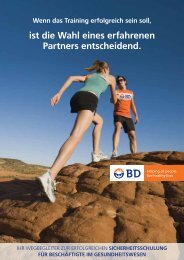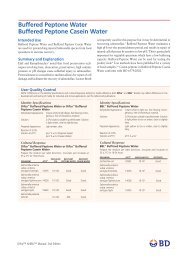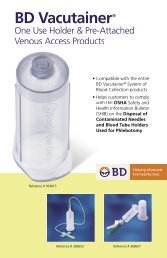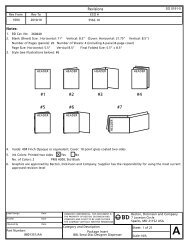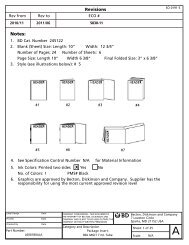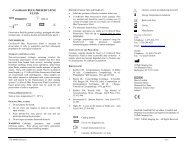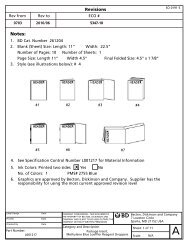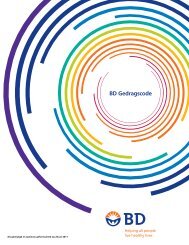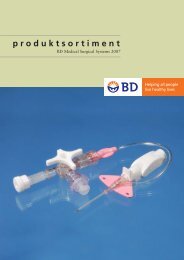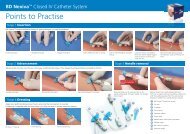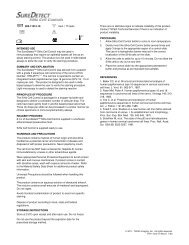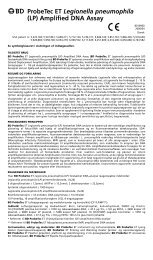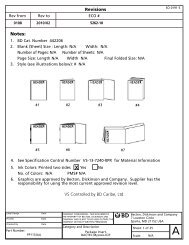MDifco Neisseria Meningitidis Antisera - BD
MDifco Neisseria Meningitidis Antisera - BD
MDifco Neisseria Meningitidis Antisera - BD
You also want an ePaper? Increase the reach of your titles
YUMPU automatically turns print PDFs into web optimized ePapers that Google loves.
S1190_Difco<strong>Neisseria</strong>(0703).qxd 10/13/2003 11:33 AM Page 3<br />
Procedural Steps<br />
1. Dispense 1 drop of the Difco <strong>Neisseria</strong> <strong>Meningitidis</strong> Antiserum to be tested<br />
on an agglutination slide.<br />
2. Transfer a loopful of growth of the test organism to the drop of antiserum<br />
and mix thoroughly.<br />
3. Rotate the slide for one min and read for agglutination.<br />
4. Repeat steps 1-3 for known positive and negative cultures.<br />
RESULTS<br />
1. Read and record results as follows:<br />
4+ 100% agglutination (background clear to slightly hazy)<br />
3+ 75% agglutination (background slightly cloudy)<br />
2+ 50% agglutination (background moderately cloudy)<br />
1+ 25% agglutination (background cloudy)<br />
– No agglutination<br />
2. The positive control should show 3+ or greater agglutination.<br />
3. The negative control should show no agglutination.<br />
4. For test isolates, a 3+ or greater agglutination within one min is a positive result.<br />
LIMITATIONS OF THE PROCEDURE<br />
1. Correct interpretation of serologic reactions depends upon culture purity<br />
and morphological characteristics and biochemical reactions that are<br />
consistent with identification of the microorganism as N. meningitidis.<br />
2. Serologic methods alone cannot identify the isolate as N. meningitidis.<br />
Organisms unrelated to <strong>Neisseria</strong>, yet capable of causing meningitis and<br />
other species of <strong>Neisseria</strong> can cross-react with meningococcal antisera.<br />
3. Excessive heat from external sources (hot bacteriological loop, burner<br />
flame, light source, etc.) may prevent a smooth suspension of the<br />
microorganism or cause evaporation or precipitation of the test mixture.<br />
False positive reactions may occur.<br />
4. Rough culture isolates do occur and will agglutinate spontaneously,<br />
causing agglutination of negative controls (autoagglutination). Smooth<br />
colonies must be selected and tested in serologic procedures.<br />
5. N. meningitidis group A and group C may cross–react due to the presence<br />
of common capsular polysaccharides.<br />
6. Group Z meningococci may agglutinate group Z’ antiserum. Group Z’<br />
meningococci will not agglutinate group Z antiserum.<br />
7. Difco <strong>Neisseria</strong> <strong>Meningitidis</strong> <strong>Antisera</strong> have been tested using undiluted<br />
cultures taken from agar media. These antisera have not been tested using<br />
antigen suspensions in saline or other diluents. If the user applies<br />
variations in the recommended steps (see Procedure) each lot of<br />
antiserum must be tested with known control cultures to verify expected<br />
reactions under the modified procedure.<br />
8. Rehydrated Difco <strong>Neisseria</strong> <strong>Meningitidis</strong> <strong>Antisera</strong> that are cloudy or have<br />
a precipitate during the period of use should be discarded.<br />
9. Confirmatory testing of uncommon serogroups X, W135, Y, Z and 29E is suggested.<br />
PERFORMANCE CHARACTERISTICS 6<br />
The performance of Difco <strong>Neisseria</strong> <strong>Meningitidis</strong> <strong>Antisera</strong>, manufactured by Difco<br />
Laboratories, was compared to two other commercially available tests for serological<br />
grouping of meningococci in a study by van der Ende, Schuurman, Hopman, Fijen and<br />
Dankert. 6 One commercial product used rabbit and mouse antibodies in slide<br />
agglutination tests. The other commercial product used rabbit and mouse antibodies<br />
in latex agglutination tests. Seventy two (72) reference strains were used in this study. 6<br />
The table below lists the number of correctly identified isolates obtained for each test system.<br />
Slide Commercial<br />
Agglutination Slide<br />
Serogroup No. of Test using Agglutination Commercial<br />
Samples Difco <strong>Neisseria</strong><br />
<strong>Meningitidis</strong><br />
<strong>Antisera</strong><br />
Test Latex Test<br />
A 10 9 10 9<br />
B 10 9 10 10<br />
C 10 9 9 10<br />
X 6 5 5 *<br />
Y 9 7 9 9†<br />
Z 4 1 4 *<br />
W135 6 5 5 6†<br />
29E (Z’)<br />
Other serogroups &<br />
2 2 * *<br />
nonencapsulated<br />
strains which should be<br />
negative by the test.<br />
15 14/15 15/17‡ 23/27‡<br />
Total 72 61/72 67/72 67/72<br />
* The other 2 commercial kits do not contain antisera to detect N. meningitidis groups X, Z<br />
and/or 29E.<br />
† Latex test cannot distinguish between N. meningitidis serogroups Y and W135.<br />
‡ Serogroup 29E and serogroups X, Z and 29E are also included for the commercial slide<br />
and latex tests, respectively.<br />
3



